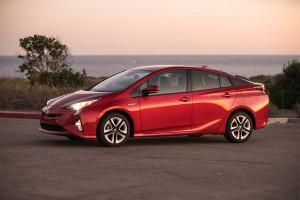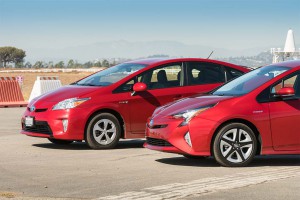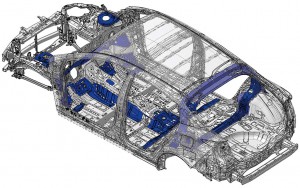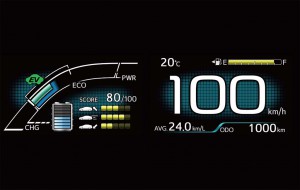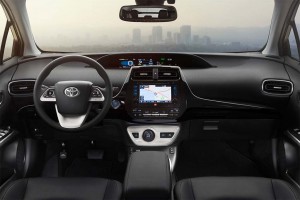I’ve long been a fan of the Toyota Prius. Now in its fourth generation, the popular hybrid vehicle is offered in several trim levels, all with the mission of getting you around comfortably and safely with great fuel economy. But in what was typical for some Toyota products of the past, previous generation Prius models weren’t exactly fun to drive.
Why is this important? you ask. After all, I just want some serious mpg returns.
In case you haven’t noticed, oil prices have plummeted and folks are back to their giant SUV and truck purchasing ways. Not to mention a major increase in sales of performance cars that now exceed 500-700 horsepower!
When the emotional “want” needle shifts towards vehicles people have on their “dream vehicle” lists, sales of small, fuel efficient vehicles tend to tank. We’ve seen it before, and it does not portend a bright future for those working diligently on electric, hybrid and hydrogen fuel cell technology to help preserve Mother Nature’s finite fossil fuel supply.
Prius can certainly be called small and fuel efficient. So to keep consumer interest strong as gas gets cheaper, Toyota has wisely instilled GT DNA into the new 2016 model.
So what does that mean? While it does a lot of things well, Prius models have never been close to being fun to drive. Steering on previous gen models is slow and somewhat imprecise, handling is sloppy, especially during evasive maneuvers, and the joy quotient as it relates to pleasure driving hovered at the five out of 10 mark.
(Toyota sets out to regain global sales crown. For more, Click Here.)
So Toyota started with a clean slate with the new Prius, determined to make this fuel-efficient buggy fun to drive. And as a plus, they restyled the new model, taking away a bit of the “Star Wars” styling that made this hybrid singularly unique.
Under the restyled body lies Toyota’s New Global Architecture (TNGA), an integrated approach to developing new platforms and powertrains. In the case of the 2016 Prius, the platform introduces a high-strength body structure, new double-wishbone independent rear suspension and low center of gravity to enhance driving dynamics to a level that speaks more German than Japanese. In a word, the new Prius is fun.
To enhance the agility and sporty driving character of the 2016 Prius, Toyota engineers replaced the torsion beam suspension with a double wishbone rear suspension. The new trailing-arm design greatly enhances handling, control and ride comfort and also allows increased luggage space.
To prove that the engineers weren’t blowing smoke in strange places, Toyota set up a Gymkhana course on a runway at the retired “El Toro” Marine Corps Air Station near Irvine, California.
First up was the previous gen Prius, and it plodded through the tight, fast course as best as it could. Plenty of body roll and understeer was exhibited by the less-than-capable chassis. “About what I expected,” was my assessment.
Time for the 2016 model, and all of my “average” Prius thoughts flew out of the redesigned side windows. Handling was spot on—like BMW spot on. Acceleration has also improved, and I was able to steer the new Prius through tight corners with my right foot. Minimal body roll, neutral handling, and balanced steering effort were among the new model’s vastly improved road traits.
(Click Here for details about Hyundai taking on the Prius with the new Ioniq.)
Honestly, I could not believe what had just happened, so I started the whole process over – again with the previous model and then with the new – with the same results. I ended up driving the 2016 repeatedly to try and improve my track time!
During on-road drives, the new Prius is equally impressive. Most notably, Prius is now considerably quieter than previous gen models. Not that hybrids are noisy to begin with, but cars at the lower end of the economic spectrum tend to get less of the sound deadening and road comfort goodies that luxury car buyers expect. Noise levels rivaled some of big brother Lexus’ smaller car offerings – an unexpected bonus.
My overall assessment of ride quality and handling is an “A” grade for the Prius. Kudos to Toyota for using the low-center of gravity battery pack in the Prius to its benefit by adding proven suspension geometry and a stiffer shock absorber profile. Well done Toyota!
As mentioned earlier, the other variable that was either loved or hated on previous Prius models was the quirky styling. Most previous devotees loved the old styling, as it says “I’m different (I’m green) and I want the whole world to know it.”
The new Prius is 2.4 inches longer, 0.6 inches wider and 0.8 inches lower than the model it replaces (on the same 106.3-in. wheelbase). Stylewise, it’s more revolutionary than evolutionary in my opinion, as it now looks as cool as a Toyota Corolla, yet those who loved the old model’s style were clearly in the corner of the 2016 Toyota Prius.
In terms of comfort, safety and convenience content, the new Prius is loaded. Again, Toyota has taken the new Prius to another level. Standard exterior features on the top-of-the-line Four Touring include: Bi-LED projector low and high-beam headlights with LED accent lights and auto off feature; LED Daytime Running Lights, heated power outside mirrors with folding feature; active grille shutters; and a Smart-Flow climate control system with pollen filtration.
The new Prius comes with plenty of convenience features, such as an integrated backup camera; a 4.2-inch Color Dual Multi-Information Display with customizable screens including Energy Monitor, Hybrid System Indicator and Eco Score, driver support systems; Smart Key System on driver’s door with Push Button Start; Qi-compatible wireless smartphone charging with charge indicator light; Entune Premium Audio with Integrated Navigation and App Suite Bundle (7-inch high resolution touch-screen with split screen display.
On the safety front, Toyota as a brand has seriously upped its safety profile. Back to El Toro, where a motorized pedestrian named “Elvis” was fodder for testing Prius’ Pedestrian Detection System, part of the “Safety Sense” system. Early detection of pedestrians is made possible by combining a millimeter-wave radar with the camera’s recognition data.
Also, the car’s bi-led headlamps are equipped with a near-infrared-ray projector to assist in nighttime detection of pedestrians. The Toyota Safety Sense Pre-Collision System with Pedestrian Detection also includes Lane Departure Alert with Steering Assist, Auto High Beams and Full-Speed Dynamic Radar Cruise Control.
Additional standard safety equipment on the Prius Four Touring trim level includes: the Star Safety System, Enhanced Vehicle Stability Control, Traction Control, Anti-l
ock brake system with Electronic Brake-force Distribution, BrakeAssist, and SmartStop Technology; Vehicle Proximity Notification System; Hill Start Control; and Blind Spot Monitor with Rear Cross-Traffic Alert.
Available Prius features include smart technologies to help take the stress out of parking. When Prius is parking or slowly pulling out of a space, the available Intelligent Clearance Sonar (ICS) scans for stationary objects. If the system anticipates a collision, it will emit an audible alert, reduce engine or electric motor output, and automatically apply the brakes.
Available Intelligent Parking Assist automatically controls the steering and help guide you into an open parking space. A color Head-Up Display is also optional. Who says economy can’t be fun?
Under the hood, Toyota’s venerable 1.8-liter engine continues duty, coupled to a permanent magnet electric motor and Lithium-Ion battery storage. Acceleration from the combined gas/electric propulsion system is brisk, yet the Prius returns an impressive 54 mpg city/50 mpg highway. “Eco” trim levels (Prius Two) up city fuel economy to 58 mpg.
(To see more about the new Lexus LC 500 hybrid, Click Here.)
Prius pricing starts at just $24,200 for the Prius Two, and just $30,000 for the tested Prius Four Touring. Safety, performance, technology and supreme fuel economy in a fun-to-drive, great handling, stylish package. Is the 2016 Prius Four Touring a good buy?
Without a doubt, it’s a great buy.

